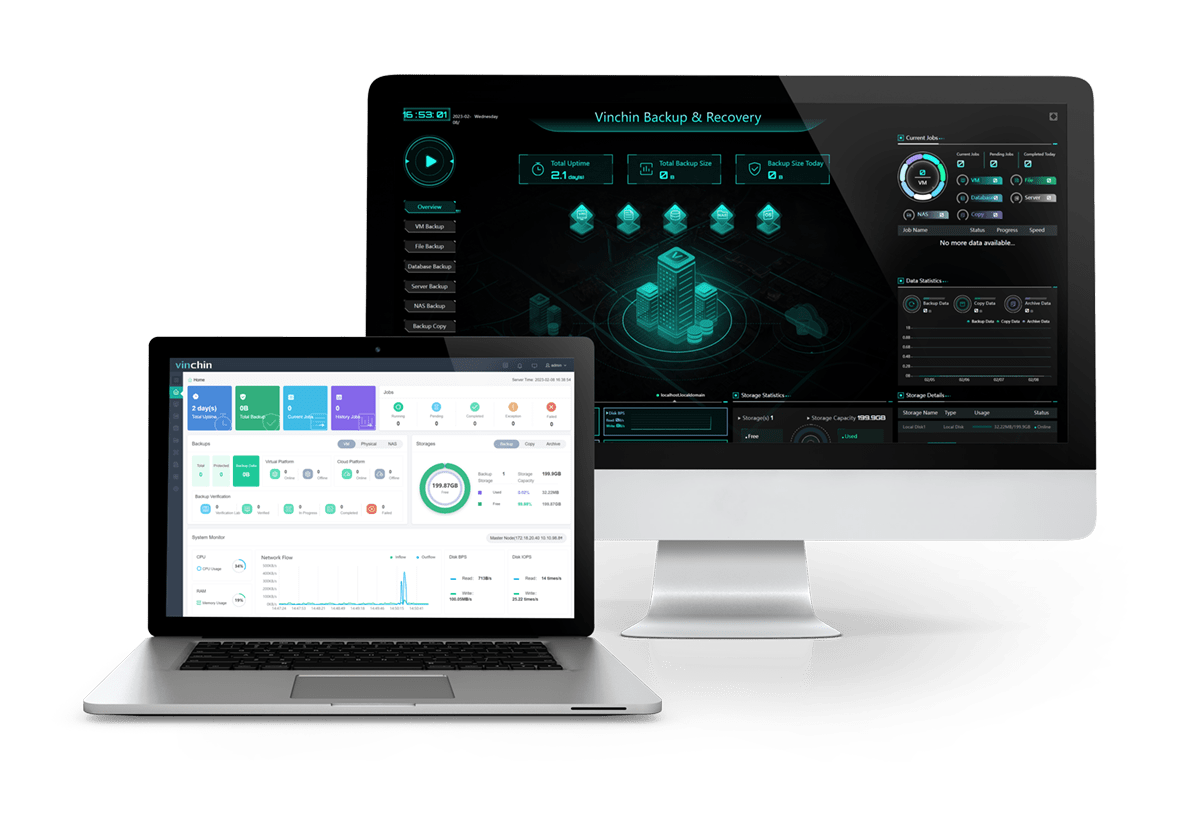-
What is RAID?
-
Commonly used RAID schemes
-
Advantages of RAID
-
RAID is not backup
-
Backup your critical data with Vinchin solution
-
Conclusion
With the advancement of information technology and the increasing demand for storage, RAID technology has gained widespread application in modern computing environments. It offers advantages such as data protection, performance enhancement, capacity expansion, and flexible management, making it a crucial tool for numerous organizations and businesses in building reliable storage solutions.
What is RAID?
In 1988, the University of California, Berkeley, first proposed and defined the concept of RAID (Redundant Array of Inexpensive Disks). Its fundamental idea is to organically combine multiple smaller capacity and relatively inexpensive disks to achieve capacity, performance, and reliability comparable to expensive large-capacity disks at a lower cost.
As disk costs and prices continued to decrease, the term "inexpensive" became meaningless as RAID could utilize a majority of disks. Therefore, the RAID Advisory Board (RAB) decided to replace "inexpensive" with "independent," and RAID became Redundant Array of Independent Disks, signifying an array composed of independent disks with redundancy capabilities.
RAID technology combines multiple disk devices into a larger and more secure disk array. It divides data into segments and stores them on different physical disk devices. By utilizing distributed reading and writing techniques, it enhances the overall performance of the disk array. Additionally, it synchronizes multiple copies of important data onto different physical disk devices, providing excellent data redundancy and backup effects.
RAID employs three main techniques—data striping, mirroring, and data parity—to achieve high performance, reliability, fault tolerance, and scalability. Depending on the strategies and architectures based on the three techniques, RAID can be classified into different levels to meet the requirements of various data applications.
Currently, there are at least a dozen RAID disk array solutions available. Considering cost and technical aspects, it is usually necessary to balance data reliability and read/write performance based on different needs and develop different solutions to meet specific requirements. The following are introductions to several commonly used RAID schemes.
Commonly used RAID schemes
RAID 0: RAID 0, also known as Stripe or Striping, represents the highest storage performance among all RAID levels. The principle behind improving storage performance in RAID 0 is to distribute consecutive data across multiple disks for access. This way, when the system receives data requests, they can be executed in parallel by multiple disks, with each disk handling its portion of the data requests. This parallel operation on the data fully utilizes the bandwidth of the bus, significantly enhancing the overall disk access performance.
The advantages of RAID 0 include low cost, improved performance, and throughput of the entire disk array, enhanced read/write speeds, and no loss of total disk capacity. It excels in handling large files quickly. However, the downside is that if any disk in the array fails, all the data becomes unrecoverable.
RAID 1: RAID 1, also known as disk mirroring, operates by mirroring the data from one disk to another. In other words, when data is written to one disk, a mirrored copy is simultaneously generated on another idle disk. This approach maximizes system reliability and recoverability without compromising performance. As long as at least one disk from any mirrored pair in the system remains functional, the system can operate normally, even if half of the disks experience issues.
The advantages of RAID 1 include doubled read performance, providing data redundancy. If one disk fails and data is lost, it can be restored from the other disk. However, the downsides are low disk utilization, higher cost, and increased load on the disk controller.
RAID 5: RAID 5 does not create backups of stored data. Instead, it stores the data and corresponding parity information across the disks that make up RAID 5, especially on different disks. When data on one disk in RAID 5 becomes damaged, the remaining data and corresponding parity information are used to recover the corrupted data.
The advantages of RAID 5 include efficient collective access to data in a block-based manner, the presence of a checksum mechanism, and high space utilization. However, the downsides are that the more disks involved in RAID 5, the lower the security performance, making it more prone to data loss. If two consecutive disks fail, the data cannot be recovered. Additionally, RAID 5 exhibits high read efficiency but average write efficiency.
RAID 10: Also known as RAID 1 + RAID 0, it is a "mirror-striped" configuration, meaning that data is striped across two mirrored arrays. The striping occurs between the arrays, while the mirroring takes place within the same array. The combination of these two techniques accelerates the rebuilding process. The number of disks in a RAID 10 array should be a multiple of four.
The advantages of RAID 10 include high speed and low fault tolerance. However, it has the drawbacks of high cost and poor scalability.
Advantages of RAID
Improved data transfer rate: RAID significantly enhances the data throughput of a storage system by simultaneously storing and accessing data across multiple disks. In RAID, multiple disk drives can transmit data concurrently, appearing as a single logical drive. As a result, RAID can achieve speeds several times, or even hundreds of times faster than a single disk drive.
Fault tolerance through data validation: Regular disk drives lack built-in fault tolerance, except for the CRC (Cyclic Redundancy Check) codes written on the disk. RAID fault tolerance is built upon the hardware fault tolerance of each disk drive, providing higher security. Many RAID modes incorporate comprehensive measures for mutual validation and recovery, including direct mirroring backups. This greatly improves the fault tolerance of RAID systems and enhances system stability and redundancy.
RAID is not backup
RAID and backup are significantly different concepts, or one could say they are not even the same concept. RAID can be considered a form of fault tolerance. Backup and fault tolerance are distinct concepts. Backup allows you to recover data after a disaster occurs, while fault tolerance reduces the probability of a disaster happening.
You can think of fault tolerance as erecting a guardrail at the edge of a cliff, while backup is establishing a hospital at the bottom of the cliff. Both the guardrail and the hospital are desirable, but they are entirely separate applications.
Although RAID writes data to two disks simultaneously, it is not a backup. If your operating system or software(excluding disk failure) deletes your data, the deletion operation will be sent to both disks and simultaneously erase the data on both disk drives. For example, in a simple scenario, if someone executes a "drop tables" operation on a database, no RAID mode can effectively protect your data. However, backup involves creating a copy of the data, storing it elsewhere, and separating it from the original data in terms of space and time. Unless your backup data is deliberately deleted, it will not be damaged. In short, even if you use RAID, you still need to employ effective backup software to protect your data from harm.
Backup your critical data with Vinchin solution
Vinchin Backup & Recovery is a professional solution which supports data backup of VM like VMware vSphere, Hyper-V, XenServer, XCP-ng, oVirt, RHV, OpenStack, etc. and other data like database, NAS, file server, etc.

It provides smart backup strategy, multithreading transmission and anti-ransomware protection, supporting image-based, agentless backup, fast incremental backup, offsite backup, LAN-free backup and recovery with a performance of saving backup storage space.
Besides, Vinchin Backup & Recovery can migrate VMs across 10+ virtual platforms including VMware, XenServer, and most KVM-based hypervisors. You can easily switch your critical modern IT workloads from one to another to build your own highly flexible IT infrastructure.
Vinchin Backup & Recovery has been selected by thousands of companies and you can also start to use this powerful system with a 60-day full-featured trial! Also, contact us and leave your needs, and then you will receive a solution according to your IT environment.
Conclusion
RAID is a technology used to enhance data storage performance or disk data reliability. It ensures the security of data after disk failures. Due to the decreasing cost of disks, it is advisable to install a RAID for critical environments or important data. However, please remember that RAID can’t replace backup, so any backup solution for your critical data is recommended.
To efficiently protect your computing environment, you can choose Vinchin Backup & Recovery to easily backup and recover your VMs and critical data. Don’t miss the free trial.
Share on:








